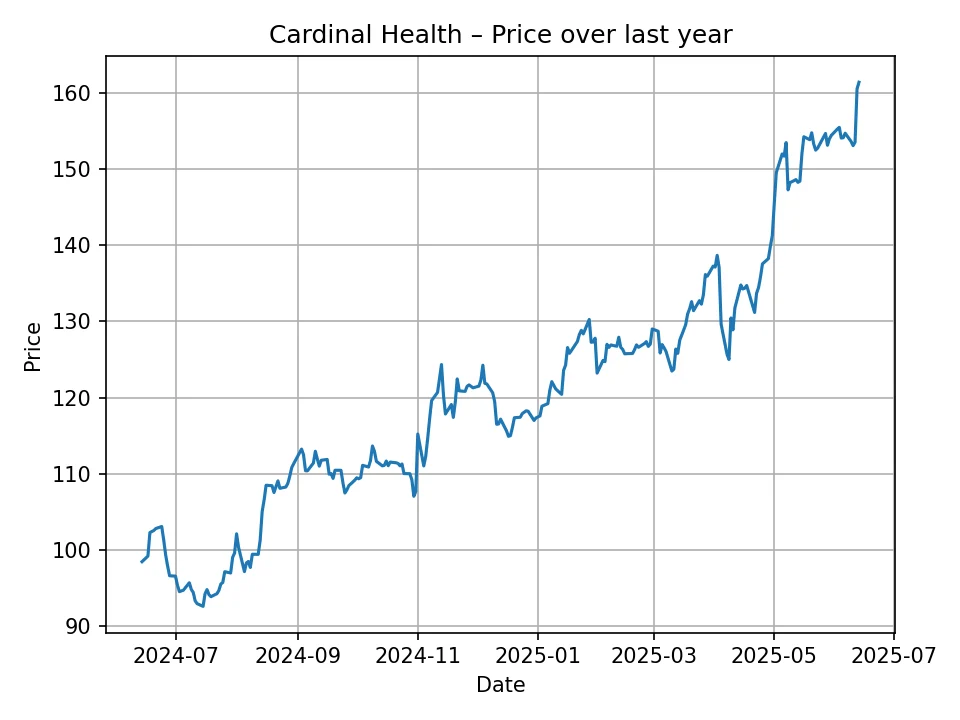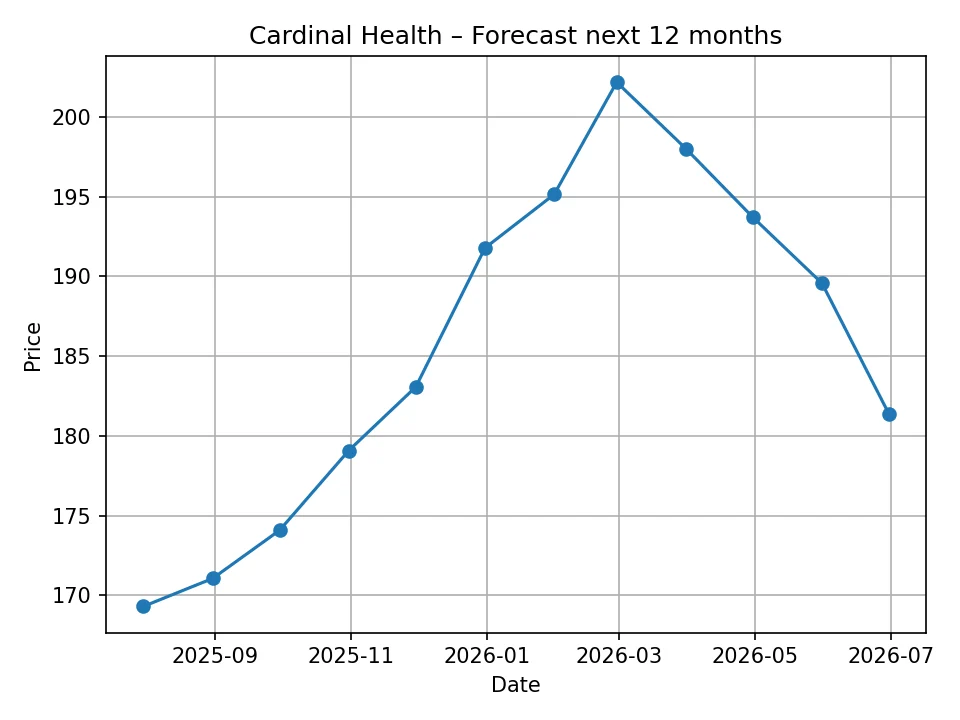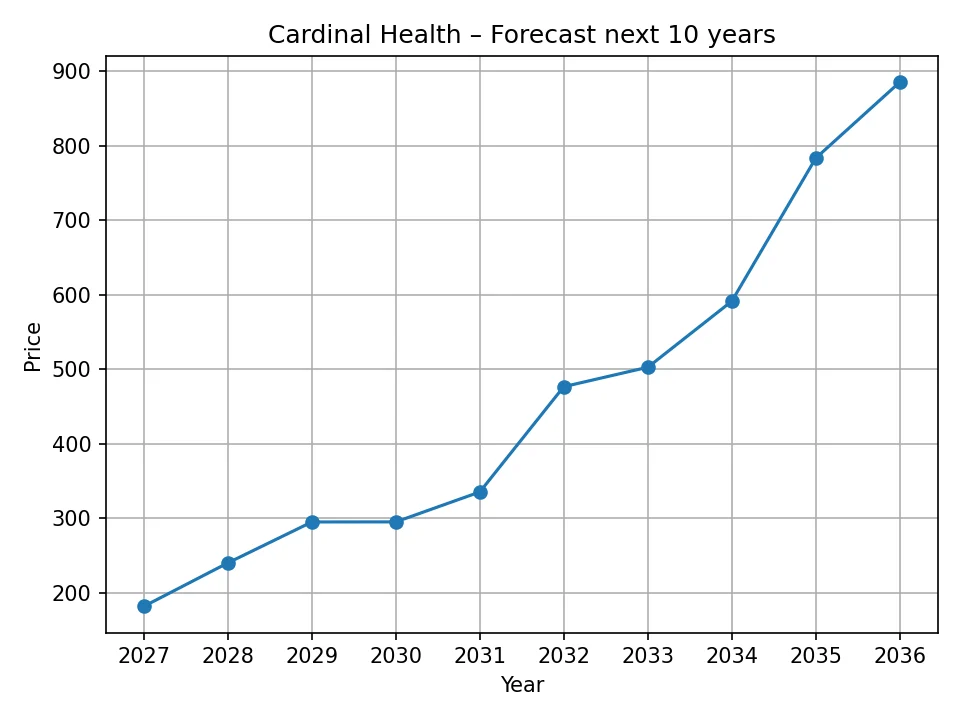Cardinal Health (NYSE: CAH) stands as a pivotal global healthcare services and products company, playing an indispensable role in the complex healthcare ecosystem. With its origins dating back to 1971, the company has evolved into a diversified leader, connecting patients and providers across the continuum of care. Headquartered in Dublin, Ohio, Cardinal Health operates primarily through two segments: Pharmaceutical and Medical. The Pharmaceutical segment is one of the largest pharmaceutical distributors in the United States, providing a broad range of branded and generic pharmaceutical drugs, specialty pharmaceuticals, and over-the-counter healthcare products. It also offers supply chain services, pharmaceutical packaging, and pharmacy management solutions to hospitals, pharmacies, and other healthcare providers.
The Medical segment manufactures and distributes a vast portfolio of medical and surgical products, including gloves, surgical drapes, gowns, and other disposable products, as well as capital equipment. It also provides laboratory products, custom kitting services, and supply chain solutions to hospitals, ambulatory surgery centers, clinical laboratories, and other healthcare facilities worldwide. This dual operational structure allows Cardinal Health to maintain a robust presence across various critical junctures of healthcare delivery, from drug distribution to medical device supply, solidifying its position as a cornerstone of the healthcare infrastructure.
As of the current date, Cardinal Health’s stock is trading at $161.41 USD. This valuation reflects a combination of its current operational performance, market sentiment, and investor expectations regarding the company’s future trajectory within the dynamic healthcare industry. Analyzing its historical performance and future projections, especially through the lens of sophisticated analytical models, provides valuable insights for both current shareholders and prospective investors. The following analysis will delve into the factors that have shaped Cardinal Health’s recent market performance and explore the projections offered by a proprietary algorithm, offering a comprehensive outlook on its potential price movements.
Historical Performance Analysis: A Year in Review for Cardinal Health Stock
Examining the historical stock performance of Cardinal Health over the past twelve months offers critical context for understanding its current valuation and anticipating future movements. The provided daily historical data, spanning from approximately $98.44 USD to the current price of $161.41 USD, illustrates a remarkably strong upward trend over this period. This signifies a substantial appreciation in shareholder value, with the stock effectively increasing by over 60% in a single year.

At the beginning of this 12-month period, the stock hovered around the $98-$99 USD mark. Initially, there were periods of consolidation and slight fluctuations, with prices oscillating between $92 USD and $103 USD in the first few months. This early volatility is common and often reflects broader market sentiment, initial reactions to quarterly reports, or sector-specific news. However, a noticeable inflection point occurred, leading to a more sustained upward momentum. We observe several distinct phases of growth:
- Initial Stability and Gradual Ascent: After some early dips to the low $90s USD, the stock showed resilience, gradually climbing back above $100 USD. This period likely coincided with positive fundamental news, such as stable earnings or reassuring market outlooks for the healthcare sector.
- Accelerated Growth Phase: A significant acceleration in price appreciation is evident as the stock moved consistently from the $110s USD to the $120s USD, and then rapidly into the $130s USD and beyond. This aggressive upward trajectory suggests increasing investor confidence, possibly fueled by strong quarterly financial results, strategic business developments, or favorable shifts in the regulatory landscape impacting healthcare distributors. For instance, the data clearly shows the stock breaking out from trading ranges in the low $100s USD to establishing new, higher plateaus.
- Sustained Bullish Momentum: In the latter part of the 12-month window, Cardinal Health demonstrated robust strength, pushing past $140 USD and eventually reaching the $150s USD and the current $161.41 USD. This consistent upward movement, with occasional minor pullbacks, indicates a dominant bullish sentiment. Such performance is often driven by a combination of factors:
- Strong Financial Performance: Consistent revenue growth, expanding profit margins, and effective cost management can significantly boost investor confidence.
- Positive Industry Tailwinds: The healthcare sector, particularly pharmaceutical distribution and medical supplies, often benefits from stable demand driven by demographic trends (aging populations, increasing chronic disease prevalence) and healthcare innovation.
- Strategic Initiatives: Any announcements related to successful acquisitions, new product launches, or expanded service offerings could have provided catalysts for growth.
- Shareholder Returns: Consistent dividends or share buyback programs can also make a stock more attractive, contributing to its upward trend.
The overall picture painted by the historical data is one of remarkable resilience and growth. The stock’s ability to nearly double its value within a year, overcoming various market fluctuations, speaks volumes about Cardinal Health’s underlying business strength and its perceived value within the healthcare industry. This strong historical performance provides a robust foundation for evaluating its future price predictions, suggesting that the company has effectively capitalized on market opportunities and managed challenges.
Key Factors Influencing Cardinal Health’s Stock Price
Understanding the intricate web of factors that influence Cardinal Health’s stock price is essential for any comprehensive analysis. The healthcare industry is notoriously complex, subject to myriad forces that can significantly impact a company’s financial health and, consequently, its market valuation. For Cardinal Health, a major player in pharmaceutical and medical product distribution, these factors can be broadly categorized into industry-specific dynamics, regulatory influences, operational efficiencies, and broader macroeconomic trends.
Industry-Specific Dynamics
The fundamental demand for Cardinal Health’s services is driven by the consistent and growing needs of the healthcare sector. An aging global population, coupled with an increasing prevalence of chronic diseases, ensures a steady demand for pharmaceuticals and medical devices. This demographic tailwind provides a stable base for the company’s long-term revenue streams. Furthermore, advancements in medical technology and the continuous development of new drugs mean a constant pipeline of products requiring efficient distribution and supply chain management—a core competency of Cardinal Health.
However, the industry also faces challenges. The consolidation of healthcare providers, particularly hospitals and pharmacy chains, can increase their bargaining power, potentially pressuring distributors’ margins. Similarly, the rise of specialty pharmaceuticals, which often require unique handling and distribution channels, presents both an opportunity for higher-value services and a challenge in adapting existing supply chain infrastructure.
Regulatory Environment and Healthcare Policy
Perhaps one of the most significant external influences on Cardinal Health is the evolving regulatory landscape. Government policies related to healthcare spending, drug pricing, reimbursement models, and pharmaceutical supply chain security can directly impact the company’s profitability and operational framework. For instance, initiatives aimed at reducing drug costs or increasing transparency in the pharmaceutical supply chain could compress margins or necessitate significant operational adjustments. Conversely, policies that promote efficient healthcare delivery or enhance the role of distributors in managing complex medical logistics could be beneficial.
The federal and state legislative environments in the U.S., where Cardinal Health has a substantial presence, are particularly critical. Any changes to the Affordable Care Act, Medicare, or Medicaid, or the introduction of new drug import/export regulations, can create ripples throughout the entire healthcare supply chain, affecting Cardinal Health’s business model and financial performance.
Competitive Landscape
Cardinal Health operates in a highly competitive environment, particularly in pharmaceutical distribution, where it contends with other giants like McKesson and AmerisourceBergen. Competition often revolves around pricing, service levels, and the ability to offer value-added solutions to healthcare providers. Intense price competition can lead to margin erosion, making operational efficiency and strategic differentiation paramount. The medical segment also faces competition from a diverse range of manufacturers and smaller distributors. Cardinal Health’s ability to maintain its market share and differentiate its offerings through innovation, superior logistics, and strong customer relationships is vital for sustained growth.
Operational Efficiency and Financial Health
At the core of Cardinal Health’s profitability lies its operational efficiency. Managing a vast and complex supply chain for pharmaceuticals and medical products requires precision, technological sophistication, and robust logistics. Any disruptions, such as supply chain bottlenecks, labor shortages, or increased transportation costs, can directly impact profitability. Investing in automation, optimizing inventory management, and leveraging data analytics to enhance forecasting and distribution are critical for maintaining competitive advantage and healthy margins.
The company’s financial health, including its balance sheet strength, debt levels, and cash flow generation, also plays a significant role in investor confidence. Strong financial metrics provide the flexibility for strategic investments, acquisitions, and returning value to shareholders, which can positively influence stock performance.
Innovation and Digital Transformation
The healthcare industry is increasingly embracing digital transformation. Cardinal Health’s investments in technology, such as data analytics, artificial intelligence for supply chain optimization, and e-commerce platforms for customer engagement, are crucial. Innovation in service offerings, such as specialty pharmacy solutions, home healthcare logistics, or value-based care models, can open new revenue streams and strengthen customer loyalty. The ability to adapt to new technologies and integrate them into its vast operations will be a key determinant of its future success.
Macroeconomic Factors
Broader macroeconomic conditions, while not unique to healthcare, nonetheless impact Cardinal Health. Inflationary pressures can increase operational costs (e.g., fuel, labor, raw materials for medical products), potentially squeezing margins. Interest rate changes can affect the cost of borrowing for capital expenditures or acquisitions. A strong or weak economic environment can also influence healthcare utilization patterns and government spending on health, indirectly impacting demand for Cardinal Health’s products and services. Global geopolitical events and trade policies can also affect international supply chains and product availability.
Considering these diverse and interconnected factors, Cardinal Health’s stock price is a dynamic reflection of its ability to navigate a complex operating environment, capitalize on industry growth drivers, and mitigate various risks. The successful management of these elements is what underpins its historical performance and will dictate its future trajectory.
Methodology for Price Prediction: The CleverCast Algorithm
The price predictions for Cardinal Health presented in this analysis are generated using a proprietary and advanced forecasting tool known as the CleverCast algorithm. This sophisticated algorithm is designed to analyze vast amounts of financial data, historical price movements, and market indicators to identify patterns and project future stock prices. Unlike simpler predictive models, CleverCast integrates multiple layers of analysis, drawing upon diverse data sources to construct a comprehensive market outlook.
At its core, the CleverCast algorithm employs a blend of statistical modeling, machine learning techniques, and fundamental analysis principles. It processes historical trading data, including daily price fluctuations, trading volumes, and volatility metrics, to understand the intrinsic behavior of the stock. Beyond raw price data, the algorithm also incorporates relevant external factors that typically influence market sentiment and corporate performance. This includes, but is not limited to, industry trends, economic indicators, and company-specific news that can be quantified and integrated into its predictive framework.
The strength of the CleverCast algorithm lies in its adaptive learning capabilities. It continuously refines its models as new data becomes available, allowing it to adjust its predictions in response to evolving market conditions and unforeseen events. This iterative learning process helps the algorithm to reduce predictive errors and enhance the accuracy of its forecasts over time. By leveraging advanced computational power, CleverCast can identify subtle correlations and complex non-linear relationships within the data that might be imperceptible to human analysis, thereby providing a robust and data-driven projection of future stock prices. The predictions for Cardinal Health, both short-term and long-term, are therefore the output of this comprehensive and continually optimizing analytical framework.
Monthly Price Forecast for Cardinal Health (Next 12 Months)
The short-to-medium term outlook for Cardinal Health, as projected by the CleverCast algorithm, suggests a continued bullish trend with some anticipated fluctuations over the next twelve months. Based on the current price of $161.41 USD, the forecast indicates a steady ascent, reaching new highs within the coming year. This projection reflects an expectation of sustained positive momentum, building upon the strong performance observed over the past year.
Table: Monthly Price Forecast (July 2025 – June 2026)
| Month/Year | Projected Price (USD) |
|---|---|
| 2025-07 | 169.31 |
| 2025-08 | 171.06 |
| 2025-09 | 174.08 |
| 2025-10 | 179.08 |
| 2025-11 | 183.07 |
| 2025-12 | 191.78 |
| 2026-01 | 195.14 |
| 2026-02 | 202.17 |
| 2026-03 | 198.01 |
| 2026-04 | 193.71 |
| 2026-05 | 189.57 |
| 2026-06 | 181.38 |

The monthly forecast indicates a clear upward trajectory, with the stock expected to consistently gain value throughout the latter half of 2025. By December 2025, the price is projected to reach $191.78 USD, representing a significant increase from its current level. This sustained growth suggests that the CleverCast algorithm identifies strong underlying fundamentals and positive market sentiment driving Cardinal Health’s valuation.
The most optimistic point in this 12-month window is projected for February 2026, with the stock potentially hitting $202.17 USD. This potential peak could be influenced by anticipated strong earnings reports, successful execution of strategic initiatives, or a general uplift in the broader healthcare sector. Reaching over $200 USD would mark a significant milestone for Cardinal Health, demonstrating continued investor confidence and robust operational performance.
However, the forecast also suggests some moderation or minor pullbacks in the subsequent months. From its February peak, the price is projected to slightly recede, moving to $198.01 USD in March, $193.71 USD in April, $189.57 USD in May, and settling at $181.38 USD by June 2026. This minor downward adjustment from the peak is not necessarily indicative of a bearish reversal but could reflect typical market corrections, profit-taking, or the assimilation of new information that adjusts expectations slightly. Such fluctuations are a natural part of stock market dynamics, even within a general upward trend.
Overall, the monthly forecast portrays a positive short-term outlook for Cardinal Health. The consistent increase in projected values, followed by a slight stabilization or minor correction, suggests that while the company is expected to continue its growth trajectory, investors should also anticipate some degree of natural market volatility. The anticipated growth could be attributed to ongoing efficiency gains, successful integration of new technologies, or a continued strong demand for its pharmaceutical and medical products within the healthcare system.
Annual Price Forecast for Cardinal Health (Next 10 Years)
The long-term prognosis for Cardinal Health, spanning the next decade as predicted by the CleverCast algorithm, is remarkably bullish. This extended forecast suggests substantial growth potential, painting a picture of significant value appreciation for shareholders over the coming years. The projections indicate that Cardinal Health is positioned for sustained expansion, driven by its strategic importance in the healthcare supply chain and broader industry trends.
Table: Annual Price Forecast (2026 – 2035)
| Year | Projected Price (USD) |
|---|---|
| 2026 | 181.38 |
| 2027 | 239.67 |
| 2028 | 294.76 |
| 2029 | 294.86 |
| 2030 | 334.99 |
| 2031 | 476.41 |
| 2032 | 502.56 |
| 2033 | 591.31 |
| 2034 | 783.38 |
| 2035 | 885.35 |

Starting with a projected price of $181.38 USD for the end of 2026 (aligning with the monthly forecast), the annual predictions show a consistent and aggressive upward trend. By 2027, the price is expected to reach $239.67 USD, crossing the $200 USD threshold and continuing its ascent towards $300 USD by 2028 at $294.76 USD. This rapid early-stage long-term growth suggests that the algorithm anticipates Cardinal Health to solidify its market position and perhaps capitalize on significant market expansion opportunities.
The forecast then shows a period of stabilization around 2029, with a price of $294.86 USD, indicating a slight plateau after robust initial gains, before resuming its strong growth. This minor pause could signify a period of consolidation or integration of previous growth initiatives before the next phase of expansion.
The most striking aspect of the long-term forecast is the dramatic acceleration in value appreciation from 2030 onwards. From $334.99 USD in 2030, the projected price surges to $476.41 USD in 2031 and crosses the $500 USD mark in 2032 at $502.56 USD. The growth becomes even more pronounced in the later years, with projections of $591.31 USD in 2033, $783.38 USD in 2034, and ultimately reaching an impressive $885.35 USD by 2035.
This projected long-term growth suggests several underlying assumptions within the CleverCast algorithm about Cardinal Health’s future and the broader healthcare industry:
- Sustained Healthcare Demand: The fundamental demographic trends driving healthcare demand—such as global population growth, an aging populace, and rising chronic disease rates—are expected to continue providing a strong tailwind for Cardinal Health’s core business.
- Strategic Expansion and Diversification: The algorithm might be factoring in Cardinal Health’s potential to expand into new high-growth areas within healthcare, such as specialized logistics for advanced therapies, greater adoption of telehealth services requiring new supply chain models, or strategic acquisitions that broaden its service portfolio and market reach.
- Operational Excellence and Technology Adoption: Continued investment in supply chain optimization, automation, and digital transformation could lead to significant efficiency gains and cost reductions, boosting profitability and investor confidence over the long term.
- Leadership in Innovation: Cardinal Health’s role in introducing new products or services that enhance healthcare delivery, or its ability to adapt to evolving industry standards and regulatory changes, could solidify its competitive advantage and drive sustained revenue growth.
- Economic Stability and Growth: The long-term forecast also implicitly assumes a generally stable global economic environment conducive to sustained corporate growth and investment in healthcare infrastructure.
While such aggressive long-term projections are subject to numerous unforeseen variables and risks, they highlight the significant potential identified by the algorithm for Cardinal Health to not only maintain its crucial role in the healthcare sector but also to achieve substantial financial growth over the next decade. Investors considering a long-term position in Cardinal Health may find these projections compelling, albeit with an understanding of the inherent uncertainties in any decade-long forecast.
Risks and Opportunities in Cardinal Health’s Future Trajectory
While the CleverCast algorithm projects a strong and positive outlook for Cardinal Health, any investment carries inherent risks, and understanding these alongside potential opportunities is crucial for a balanced perspective. The long-term trajectory of Cardinal Health will be shaped by its ability to navigate challenges and capitalize on emerging trends within the complex healthcare landscape.
Key Risks
- Regulatory and Political Uncertainty: The healthcare industry is heavily regulated. Changes in drug pricing policies, reimbursement models, or supply chain regulations (e.g., related to drug imports or domestic manufacturing incentives) could significantly impact Cardinal Health’s business model and profitability. Political shifts can lead to unpredictable policy changes.
- Intensified Competition: The pharmaceutical and medical products distribution markets are highly competitive, dominated by a few large players. Price wars, new market entrants (especially from technology companies), or innovative business models could erode market share and compress margins.
- Supply Chain Disruptions: As a global distributor, Cardinal Health is vulnerable to supply chain disruptions caused by geopolitical events, natural disasters, pandemics, or trade disputes. These can lead to increased costs, product shortages, and delays, impacting service delivery and financial performance.
- Litigation and Compliance Risks: The healthcare sector is prone to legal challenges, including those related to opioid distribution, antitrust issues, or product liability. Significant litigation costs or adverse judgments can severely impact financial results and reputation. Maintaining strict compliance with a myriad of healthcare laws is a continuous challenge.
- Technological Obsolescence: While technology presents opportunities, a failure to adapt to or invest in new technologies for logistics, inventory management, or customer engagement could leave Cardinal Health at a disadvantage compared to more agile competitors.
- Economic Downturns: While healthcare is generally resilient during economic recessions, severe downturns can impact healthcare spending, patient volumes, and the financial health of healthcare provider clients, indirectly affecting demand for Cardinal Health’s services.
Key Opportunities
- Aging Population and Chronic Disease Growth: These fundamental demographic trends ensure a sustained and growing demand for pharmaceuticals and medical devices, providing a robust base for Cardinal Health’s core distribution business for decades to come.
- Expansion into Specialty Healthcare: The market for specialty pharmaceuticals and complex medical devices is growing rapidly. These often require sophisticated logistics, cold chain management, and patient support services, areas where Cardinal Health can leverage its expertise to offer higher-value services and capture greater margins.
- Digital Transformation and Data Analytics: Investing further in digital platforms, AI-driven logistics, and advanced data analytics can significantly enhance operational efficiency, optimize inventory, improve forecasting, and offer deeper insights to healthcare provider clients, creating new revenue streams and competitive advantages.
- Strategic Acquisitions and Partnerships: Cardinal Health can enhance its capabilities and market reach through targeted acquisitions of smaller, innovative companies in specific healthcare niches or through strategic partnerships that expand its service offerings (e.g., in telehealth support, home healthcare logistics, or pharmacy solutions).
- Value-Added Services: Beyond mere distribution, Cardinal Health can grow by offering more value-added services, such as inventory management solutions for hospitals, pharmacy management consulting, drug waste management, or technology integration support, deepening its relationship with clients.
- Global Market Expansion: While primarily focused on the U.S., opportunities exist to expand its presence in key international markets, particularly in developing economies where healthcare infrastructure and demand are growing rapidly.
By effectively managing these risks and strategically pursuing identified opportunities, Cardinal Health has the potential to validate the strong bullish projections presented by the CleverCast algorithm, reinforcing its position as a critical player in the evolving global healthcare industry.
Conclusion: A Bullish Outlook for Cardinal Health
In conclusion, Cardinal Health stands as a formidable entity within the global healthcare landscape, providing essential pharmaceutical and medical product distribution services that underpin the efficient functioning of healthcare systems worldwide. Its established infrastructure, deep industry relationships, and critical role in connecting manufacturers with providers position it strongly for continued relevance and growth.
The analysis of Cardinal Health’s historical performance reveals a significant growth trajectory over the past year, with the stock appreciating substantially, showcasing its resilience and ability to generate value amidst various market conditions. This strong foundation provides a compelling backdrop for future price projections.
The forecasts generated by the proprietary CleverCast algorithm paint a decidedly bullish picture for Cardinal Health’s stock. The monthly predictions indicate a consistent upward trend for the next year, with the stock potentially reaching over $200 USD, followed by minor corrections typical of market dynamics. More strikingly, the long-term annual forecast extends this optimism, projecting an impressive increase in value, potentially reaching nearly $900 USD by 2035. This long-term view suggests that the algorithm anticipates Cardinal Health will not only maintain its pivotal market position but also significantly expand its value through strategic growth, operational excellence, and leveraging ongoing demographic and healthcare industry tailwinds.
While such robust projections are exciting for investors, it is crucial to remember that the future remains subject to numerous variables. Cardinal Health’s trajectory will be influenced by its ability to navigate complex regulatory environments, manage competitive pressures, innovate its supply chain and service offerings, and adapt to broader macroeconomic shifts. However, given its foundational role in healthcare and the strategic advantages it possesses, the long-term outlook appears to be highly positive.
Disclaimer: The price forecasts provided in this article are generated by a proprietary algorithm (CleverCast) and are based on historical data and market analysis. These predictions are for informational purposes only and do not constitute financial advice. Investing in the stock market involves significant risks, and past performance is not indicative of future results. We are not responsible for any investment decisions made based on these forecasts. Investors should conduct their own research and consult with a qualified financial advisor before making any investment choices.

Oliver brings 12 years of experience turning intimidating financial figures into crystal-clear insights. He once identified a market swing by tracking a company’s suspiciously high stapler orders. When he’s off the clock, Oliver perfects his origami… because folding paper helps him spot market folds before they happen.